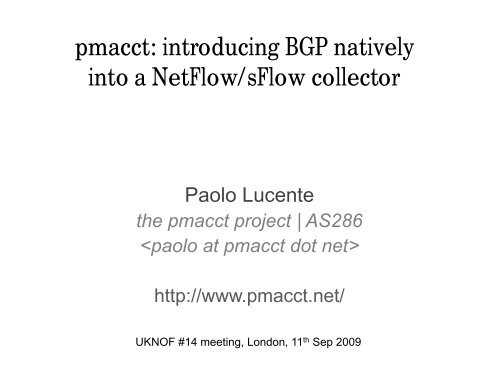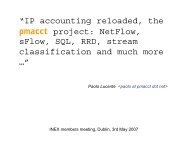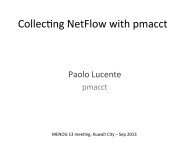pmacct: introducing BGP natively into a NetFlow/sFlow collector
pmacct: introducing BGP natively into a NetFlow/sFlow collector
pmacct: introducing BGP natively into a NetFlow/sFlow collector
You also want an ePaper? Increase the reach of your titles
YUMPU automatically turns print PDFs into web optimized ePapers that Google loves.
<strong>pmacct</strong>: <strong>introducing</strong> <strong>BGP</strong> <strong>natively</strong><br />
<strong>into</strong> a <strong>NetFlow</strong>/<strong>sFlow</strong> <strong>collector</strong><br />
Paolo Lucente<br />
the <strong>pmacct</strong> project | AS286<br />
<br />
http://www.<strong>pmacct</strong>.net/<br />
UKNOF #14 meeting, London, 11 th Sep 2009
<strong>pmacct</strong>: <strong>introducing</strong> <strong>BGP</strong> <strong>natively</strong><br />
<strong>into</strong> a <strong>NetFlow</strong>/<strong>sFlow</strong> <strong>collector</strong><br />
Agenda<br />
I. Introduction<br />
II. Recent developments<br />
UKNOF #14 meeting, London, 11 th Sep 2009
<strong>pmacct</strong> is open-source, free, GPL’ed software
<strong>pmacct</strong>: where is it sitting?
<strong>pmacct</strong>: typical usage scenarios
<strong>pmacct</strong>: <strong>introducing</strong> <strong>BGP</strong> <strong>natively</strong><br />
<strong>into</strong> a <strong>NetFlow</strong>/<strong>sFlow</strong> <strong>collector</strong><br />
Agenda<br />
I. Introduction<br />
II. Recent developments<br />
UKNOF #14 meeting, London, 11 th Sep 2009
The <strong>BGP</strong> peer who came from<br />
<strong>NetFlow</strong> (and <strong>sFlow</strong>)<br />
– <strong>pmacct</strong> introduces a Quagga-based <strong>BGP</strong> daemon<br />
• Implemented as a parallel thread within the <strong>collector</strong><br />
• Doesn’t send UPDATEs and WITHDRAWs whatsoever<br />
• Behaves as a passive <strong>BGP</strong> neighbor<br />
• Maintains per-peer <strong>BGP</strong> RIBs<br />
• Supports 32-bit ASNs<br />
• Supports both IPv4 and IPv6<br />
– Joins <strong>NetFlow</strong> (or <strong>sFlow</strong>) and <strong>BGP</strong> data basing on:<br />
• <strong>NetFlow</strong> source address == <strong>BGP</strong> source address
The <strong>BGP</strong> peer who came from<br />
<strong>NetFlow</strong> (and <strong>sFlow</strong>) (cont.d)<br />
– Relevant implementation details:<br />
• Bases on trust: peers are not defined but a max<br />
number of peers who can connect is defined instead<br />
• Ensures i<strong>BGP</strong> peering by presenting itself as part of<br />
the AS of the neighbor, as read in the OPEN message<br />
• Enables the following traffic aggregation primitives:<br />
AS path, Local Preference, MED, Peer ASNs (freely<br />
mixed with origin ASNs), Communities, Peer IPs<br />
– Caveats:<br />
• <strong>BGP</strong> multi-path is not supported
The <strong>BGP</strong> peer who came from<br />
<strong>NetFlow</strong> (and <strong>sFlow</strong>) illustrated
Theory applied, SQL example (1/3)<br />
shell> cat <strong>pmacct</strong>-create-db_bgp_v1.mysql<br />
[ … ]<br />
<strong>BGP</strong><br />
Fields<br />
create table acct_bgp (<br />
Tag<br />
Counters<br />
Time<br />
);<br />
agent_id INT(4) UNSIGNED NOT NULL,<br />
as_src INT(4) UNSIGNED NOT NULL,<br />
as_dst INT(4) UNSIGNED NOT NULL,<br />
peer_as_src INT(4) UNSIGNED NOT NULL,<br />
peer_as_dst INT(4) UNSIGNED NOT NULL,<br />
peer_ip_src CHAR(15) NOT NULL,<br />
shell> cat pretag.map<br />
peer_ip_dst CHAR(15) NOT NULL,<br />
id=100 peer_src_as=<br />
comms CHAR(24) NOT NULL,<br />
id=80 peer_src_as=<br />
as_path CHAR(21) NOT NULL,<br />
id=50 peer_src_as=<br />
local_pref INT(4) UNSIGNED NOT NULL,<br />
[ … ]<br />
med INT(4) UNSIGNED NOT NULL,<br />
packets INT UNSIGNED NOT NULL,<br />
bytes BIGINT UNSIGNED NOT NULL,<br />
stamp_inserted DATETIME NOT NULL,<br />
stamp_updated DATETIME,<br />
PRIMARY KEY (…)<br />
shell> cat peers.map<br />
id=65534 ip=X in=A<br />
id=65533 ip=Y in=B src_mac=J<br />
id=65532 ip=Z in=C bgp_nexthop=W<br />
[ … ]<br />
shell> mysql -u root -p < <strong>pmacct</strong>-create-db_bgp_v1.mysql
Theory applied, SQL example (2/3)<br />
• See traffic delivered to a specific <strong>BGP</strong> peer<br />
mysql> SELECT peer_as_dst, bytes, stamp_inserted \<br />
FROM acct_bgp \<br />
WHERE peer_as_dst = \<br />
GROUP BY peer_as_dst<br />
• Same as above but also per location if peering at<br />
multiple places<br />
mysql> SELECT peer_as_dst, peer_ip_dst, bytes, stamp_inserted \<br />
FROM acct_bgp \<br />
WHERE peer_as_dst = \<br />
GROUP BY peer_as_dst, peer_ip_dst<br />
• Simply replace “dst” with “src” in the above<br />
examples to see incoming traffic
Theory applied, SQL example (3/3)<br />
• See outgoing traffic breakdown to all <strong>BGP</strong> peers<br />
of the same kind (ie. peers, customers, transit)<br />
mysql> SELECT peer_as_dst, bytes, stamp_inserted \<br />
FROM acct_bgp \<br />
WHERE local_pref = \<br />
GROUP BY peer_as_dst
Why integrating <strong>BGP</strong> at the <strong>collector</strong>?<br />
– One might argue validity of the work: “hey,<br />
this all could have been done at the router!”.<br />
– Maintaining per-peer <strong>BGP</strong> RIBs at the <strong>collector</strong><br />
has several advantages; some implemented:<br />
• Follow default route, having the <strong>BGP</strong> RIB of the<br />
default gateway of a PE with partial <strong>BGP</strong> view or<br />
default-only<br />
• Decouple <strong>NetFlow</strong> from <strong>BGP</strong> by mapping <strong>NetFlow</strong><br />
agents to <strong>BGP</strong> peers<br />
• Give better chances to the source peer-AS (later)
Miscellaneous features implemented<br />
– AS Path radius:<br />
• AS PATHs can get long. This can easily get counter<br />
productive (ie. waste space)<br />
• Cuts AS Path down to the specified number of AS<br />
hops. Assumption: people might be more<br />
interested <strong>into</strong> what happens around them.<br />
– Communities pattern filter<br />
• IP prefixes can have many communities attached<br />
• Only a small subset might be relevant to the<br />
accounting infrastructure<br />
• Hence filtering capabilities are made available
The source peer AS issue<br />
– Traffic is traditionally routed to destination<br />
– Problem #1: limited information about where<br />
traffic enters the AS domain. Applying this to<br />
traditional <strong>NetFlow</strong> it means: either origin<br />
ASNs OR peer ASNs<br />
– Problem #2: asymmetric routing. Applying this<br />
to traditional <strong>NetFlow</strong> it means: FIB lookup on<br />
the source prefix; result: source peer AS is<br />
where traffic should have entered the AS<br />
domain, if it was symmetrical.
The source peer AS issue mitigated<br />
– Having per-peer <strong>BGP</strong> RIBs on-board paves the<br />
way to capture both origin AND peer ASNs<br />
– Source peer AS is statically mapped against:<br />
• A whole port, ie. input port field.<br />
• Source MAC address. Should be the way to go and<br />
depends on <strong>NetFlow</strong> v9 or <strong>sFlow</strong>.<br />
• <strong>BGP</strong> next-hop lookup against the source prefix:<br />
• Only choice if running <strong>NetFlow</strong> v5 in scenarios where<br />
multiple peers are off a single port (ie. IXP)<br />
• Accuracy is not really predictable<br />
• Combine with input port to limit false positives
Auto-discovery of source peer ASNs<br />
– Mix of: SNMP, “bgp_neighbors_file” feature and<br />
<strong>pmacct</strong> maps reloadable at runtime:<br />
• Fetch all e<strong>BGP</strong> peers from bgpPeerTable<br />
• Having local IP addresses fetch ifIndex from ipAddrTable<br />
• Detect multiple e<strong>BGP</strong> peers (ie. IXP scenarios) off the<br />
same (sub-)interface so that src_mac or bgp_nexthop<br />
can be appended. For example, check netmask length<br />
• Detect e<strong>BGP</strong> multi-hops by checking ifIndex against<br />
Loopback interfaces. If true, resolve in ipCidrTable<br />
– Establish a small set of rules within your group, ie.<br />
when setting interface descriptions (ifAlias)
Auto-discovery of source peer ASNs<br />
Router<br />
configuration<br />
template<br />
…<br />
router bgp 65530<br />
neighbor X remote-as 65530<br />
neighbor X source-address 1.1.1.1<br />
…<br />
post-processing<br />
(ie. ipCidrTable)<br />
bgpPeerTable then<br />
ie. ipAddrTable<br />
shell> snmpwalk –c secret … \<br />
1.1.1.1 bgpPeerTable<br />
bgp_max_peers: 100<br />
bgp_neighbors_file: routers.list<br />
bgp_peer_as_src_map: peers.map<br />
(reloadable at runtime)<br />
shell> cat routers.list<br />
1.1.1.1<br />
...<br />
ifAlias<br />
shell> cat peers.map<br />
id=65534 ip=1.1.1.1 in=1
The case of entities on the provider<br />
– For such entities:<br />
IP address space<br />
• AS PATH would be empty;<br />
• origin and peer ASNs would be NULL.<br />
– Problem: how to recognize them?<br />
– Include IP prefix information in the DB structure:<br />
cumbersome and wouldn’t scale.<br />
– Split approach:<br />
• Source: map ifIndexes or MAC addresses to peer AS<br />
• Destination: rely on <strong>BGP</strong> communities
The case of entities on the provider<br />
IP address space (cont.d)<br />
– Ad-hoc feature (bgp_stdcomm_pattern_to_asn):<br />
• Prerequisite: entities on the provider IP address space<br />
get tagged with a standard <strong>BGP</strong> community. You are in<br />
full control of the granularity of the assignment.<br />
• <strong>pmacct</strong> config: bgp_stdcomm_pattern_to_asn: XXX:Y..<br />
• Say, an entity is tagged with community XXX:YYY; XXX<br />
value is mapped to the peer AS; YYY value is mapped to<br />
the origin AS.<br />
• Works transparently for both sources and destinations;<br />
in future can make use of extended <strong>BGP</strong> communities.
Miscellaneous implementation details<br />
– A <strong>BGP</strong> RIB of ~275-290K entries accounts for<br />
some 35-40MB of memory. Multiply this by<br />
the number of peers giving the full table.<br />
– Attributes table is shared amongst all the RIBs;<br />
it typically takes ~10MB of memory.<br />
– <strong>BGP</strong> RIB implements a binary tree; attributes<br />
table implements hashing.<br />
– RIB entries have pointers to attributes; once<br />
an attribute is not referenced by any RIB entry,<br />
it is removed.
<strong>pmacct</strong>: <strong>introducing</strong> <strong>BGP</strong> <strong>natively</strong><br />
<strong>into</strong> a <strong>NetFlow</strong>/<strong>sFlow</strong> <strong>collector</strong><br />
Thanks for your attention!<br />
Questions?<br />
Paolo Lucente<br />
the <strong>pmacct</strong> project | AS286<br />
<br />
http://www.<strong>pmacct</strong>.net/<br />
UKNOF #14 meeting, London, 11 th Sep 2009







